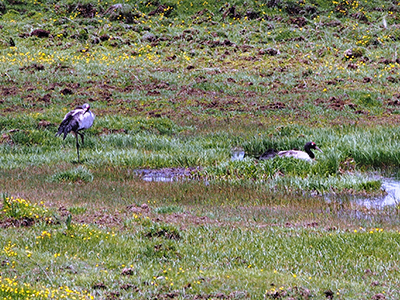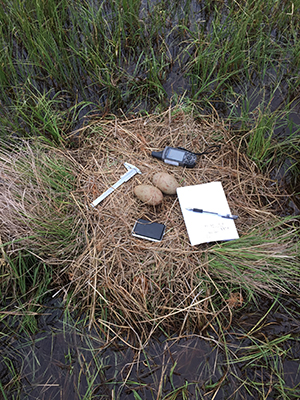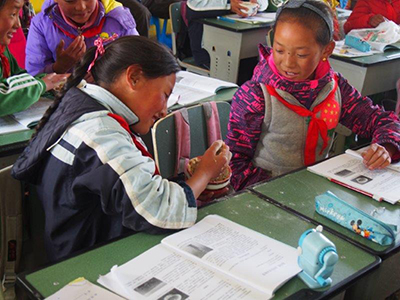 In early June, I boarded a 13-hour flight from Chicago to Beijing to begin the first stage of my two-day journey to Ruoergai National Nature Reserve in southwest China. Over 500 Black-necked Cranes summer on this remote landscape amid Tibetan herders and Chinese tourists visiting this exotic landscape.
In early June, I boarded a 13-hour flight from Chicago to Beijing to begin the first stage of my two-day journey to Ruoergai National Nature Reserve in southwest China. Over 500 Black-necked Cranes summer on this remote landscape amid Tibetan herders and Chinese tourists visiting this exotic landscape.
I joined International Crane Foundation Black-necked Crane Program leader Li Fengshan, along with three visiting U.S. Forest Service staff members, at the reserve for two weeks of field work and information exchange (and of course excellent food!) An important goal of our visit was assisting the reserve staff in developing a monitoring plan for Black-necked Cranes – in part using our experiences monitoring Sandhill and Whooping Cranes in the United States.
We estimate that approximately 10,000 Black-necked Cranes remain in central Asia, and the International Crane Foundation’s research focuses on expanding the size and range of these populations, which are threatened by habitat loss and, increasingly, climate change. We are undertaking long-term monitoring of select crane breeding areas, such as Ruoergai, to assess the impacts of climate change on cranes and key wetlands, and to develop measures to adapt to these impending changes.
 Our daily activities at the reserve varied; most days involved establishing effective survey routes to observe and count cranes. By using a GPS and pouring over maps, we were able to see a considerable amount of the sedge marshes favored by the cranes for nesting. We also spent time with a Sichuan University Graduate student studying Black-necked Crane breeding ecology. He is gathering information on the size of the crane nests, surrounding plant composition, and information about the eggs. Given that the entirety of the reserve is actively grazed, we worked with the Forest Service staff to set up ways to measure the effects of heavy grazing in the area.
Our daily activities at the reserve varied; most days involved establishing effective survey routes to observe and count cranes. By using a GPS and pouring over maps, we were able to see a considerable amount of the sedge marshes favored by the cranes for nesting. We also spent time with a Sichuan University Graduate student studying Black-necked Crane breeding ecology. He is gathering information on the size of the crane nests, surrounding plant composition, and information about the eggs. Given that the entirety of the reserve is actively grazed, we worked with the Forest Service staff to set up ways to measure the effects of heavy grazing in the area.
Our group also visited a local Tibetan school to strengthen environmental education efforts at the reserve. The students exhibited typical behavior when a number of adult visitors suddenly appeared in their classroom and sat in the back – curiosity! But they immediately responded when the teacher started the lesson on Tibetan Culture. We set about making a traditional herdsman meal of yak butter, milk, and barley flour. When kneaded together in our hand it became a smooth, solid paste that is nutritious and easily transported. Yum! Over time, we hope that increasing community awareness and pride in crane conservation will lead to stronger protection for Black necked Cranes in Ruoergai as it has in other areas of China.
 The first-annual Black-necked Crane survey yielded a count of 225 cranes from four routes in the reserve. Given the accessibility of the area, and personnel and financial limitations, the survey was designed to cover only part of the reserve (using these data we then estimated the total number of cranes in the reserve). We observed few nests in the four days we were in the reserve, but we counted many pairs, indicating that some of the cranes were either not yet nesting or had lost their nests. However, we did spot a couple family groups foraging in the reserve with two chicks, which is always a delight to see!
The first-annual Black-necked Crane survey yielded a count of 225 cranes from four routes in the reserve. Given the accessibility of the area, and personnel and financial limitations, the survey was designed to cover only part of the reserve (using these data we then estimated the total number of cranes in the reserve). We observed few nests in the four days we were in the reserve, but we counted many pairs, indicating that some of the cranes were either not yet nesting or had lost their nests. However, we did spot a couple family groups foraging in the reserve with two chicks, which is always a delight to see!
After two weeks at Rueorgai, I learned a new appreciation for the ability of cranes to adapt. Not only do Black-necked Cranes nest at a very high altitude, here they are also surrounded by human activity. Even though they are hardy birds, there is a balance on this landscape that must be carefully monitored to ensure it is maintained. The reserve staff were left with many suggestions from our team on ways to measure and document changes from grazing, fluctuating marsh water levels, and tourism, as well as techniques to continue to slow down desertification within the reserve. I hope that this productive partnership can be continued into the future, for the good of the high plateau, the people that inhabit it, and the cranes!
 Story submitted by Anne Lacy, International Crane Foundation Crane Research Coordinator. Learn more about our East Asia program.
Story submitted by Anne Lacy, International Crane Foundation Crane Research Coordinator. Learn more about our East Asia program.
